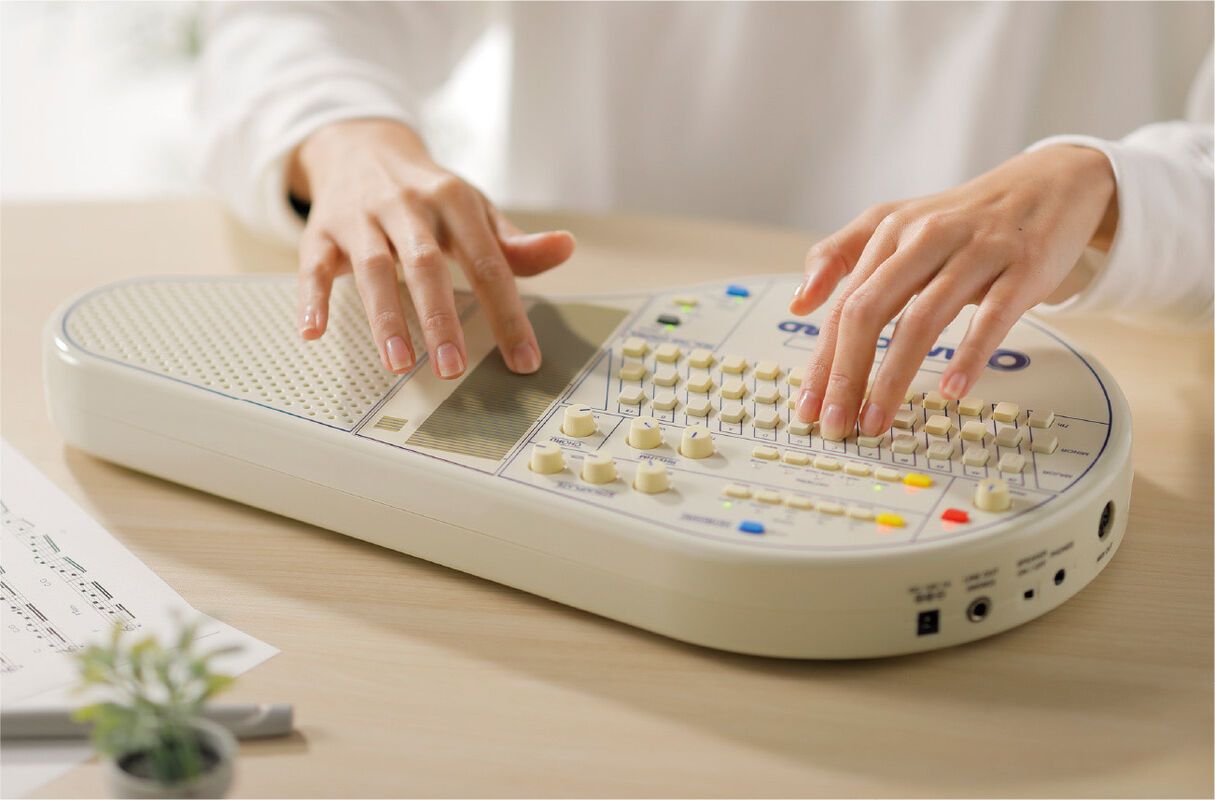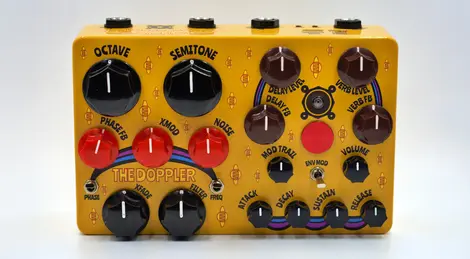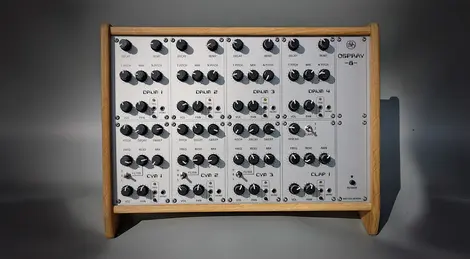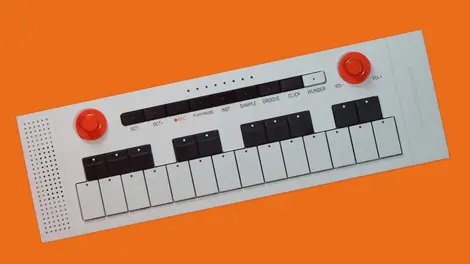Suzuki Omnichord OM-108: The Return of a Legendary Electronic Autoharp
The Suzuki Omnichord has returned. After disappearing from the market for nearly three decades, this unique electronic autoharp is back with the OM-108 model, bringing both nostalgic charm and modern upgrades to musicians worldwide.
A Brief History of the Omnichord
The original Omnichord debuted in 1981 with a simple yet revolutionary concept: make music creation accessible to everyone, regardless of musical training. Suzuki designed this electronic autoharp to combine the ease of chord buttons with an expressive strumplate that allowed players to create beautiful, harp-like sounds by simply sliding their fingers across its surface.
The instrument gained cult status throughout the 1980s and early 1990s, appearing in countless recordings and live performances. Artists appreciated its unique sound and intuitive interface that let anyone create professional-sounding accompaniments. However, production ended with the OM-300 model in 1996, leaving a devoted fanbase waiting for its return.
Enter the OM-108: Modern Revival of a Classic
Released in 2024 as part of Suzuki's 70th anniversary celebrations, the OM-108 brings the Omnichord into the modern era while preserving everything that made the original special. The model number "108" isn't arbitrary – it represents the total number of chord types this instrument can play, a significant expansion from earlier models.

Key Features and Capabilities
The Strumplate remains the OM-108's most distinctive feature. This touch-sensitive surface responds to finger movements in three ways: sliding creates chord strokes and glissando effects, tapping produces individual notes for arpeggio playing, and holding generates continuous sustained sounds. The strumplate has been improved from previous models with a wider surface that better accommodates natural hand movements, making it more comfortable for extended playing sessions.
Massive Chord Library - With 108 total chord types across 12 root notes, the OM-108 offers comprehensive harmonic possibilities including major and minor chords, 7th and Major 7th chords, minor 7th chords, augmented and diminished chords, suspended 4th chords, and add 9th chords. This expanded chord library includes popular progressions used in contemporary music, making the instrument relevant for modern songwriting and performance.
Analog Sound Heritage sets the OM-108 apart from digital alternatives. Suzuki incorporated actual analog circuits from the beloved OM-84 model, ensuring that the signature "Mellow Pulse" and "Tremolo Pulse" voices retain their original character and warmth. These aren't digital emulations – they're actual analog components that produce the warm, slightly unpredictable tones that defined 1980s electronic music.
Ten Distinct Voices offer carefully crafted sounds, each consisting of main and sub tones that can be balanced to create unique textures. The collection includes Omni 1 & Omni 2 (classic Omnichord sounds with analog circuitry), Harp (orchestral pedal harp simulation), Celeste (soft, subtle struck idiophone sounds), Acoustic Piano (grand piano tones optimized for strumplate playing), Guitar (steel-string acoustic guitar with natural resonance), FM Piano (1980s digital piano sounds perfect for ballads), Organ (Hammond organ with fifth drawbar setting and chorus), Vibes (vibraphone with spinning fan effects), and Banjo (five-string resonator banjo for country and folk styles).
Modern Enhancements
Keyboard Mode Innovation transforms the chord buttons into a 20-key melody keyboard, opening up entirely new playing possibilities. This groundbreaking feature includes full octave shifting (up and down), monophonic and polyphonic playing modes, drum pad functionality on both buttons and strumplate, and layer capabilities for complex arrangements.
Rhythm Section and MIDI Integration provide modern connectivity alongside traditional accompaniment. Ten built-in rhythm patterns deliver rhythmic backing across various musical styles including rock (multiple variations), disco and hip hop, country and bossanova, swing and waltz, plus additional contemporary patterns. The rhythm section operates in multiple modes, from simple click tracks to full automatic accompaniment with bass lines that follow chord changes. MIDI OUT capability allows the OM-108 to control external synthesizers, drum machines, and recording software through five MIDI channels transmitting different performance aspects: main voice/melody (CH1), chord information (CH2), bass line (CH3), sub voice (CH4), and drum patterns (CH10). MIDI clock synchronization ensures perfect timing when integrating with other electronic instruments or digital audio workstations.
Practical Considerations
Power and Portability - The OM-108 maintains the portable spirit of its predecessors with battery operation using eight AA batteries, providing approximately 8 hours of continuous use. For extended sessions, an optional AC adapter is available. The built-in speaker means you can play anywhere without additional equipment.
Build Quality and Design - At 45.7 x 25.0 x 5.18 cm and weighing just 1.2 kg, the OM-108 strikes an excellent balance between portability and robust construction. Soft-touch rubber buttons provide excellent tactile feedback, while the widened strumplate accommodates various hand sizes comfortably.
Accessories enhance the playing experience beyond the basic package that includes a startup guide and keyboard overlay. Suzuki offers strap buttons to convert the instrument into a wearable performance tool, a gig bag for professional protection during transport, and an AC adapter for reliable power in studio settings.
Who Should Consider the OM-108?
Complete Beginners will find the Omnichord's original mission intact – making music accessible to non-musicians. The simple interface lets anyone create beautiful music within minutes of picking up the instrument.
Songwriters and Composers benefit from the comprehensive chord library and intuitive interface that make the OM-108 an excellent songwriting tool. The ability to quickly audition chord progressions and create instant accompaniments can spark new creative ideas.
Electronic Music Producers will appreciate the unique analog textures and MIDI capabilities that make the OM-108 valuable for seeking distinctive sounds. Its retro character can add warmth and personality to digital productions.
Performers and Buskers find the battery operation, built-in speaker, and optional strap perfect for street performance or intimate acoustic settings where traditional instruments might be impractical.
Vintage Gear Enthusiasts can enjoy authentic analog sounds from the golden age of electronic music, faithfully preserved in a modern instrument that offers the best of 1980s electronic character.
Creative Possibilities
The OM-108's versatility extends far beyond simple chord accompaniment. Ambient and Atmospheric Music benefits from the sustained tones and ethereal quality of the strumplate, which makes it perfect for ambient compositions. Layer multiple voices with different sustain settings to create rich, evolving soundscapes.
Folk and Acoustic Music applications shine with the guitar and banjo voices, combined with appropriate rhythm patterns, providing authentic backing for folk songs. The natural playing motion feels organic and musical, making it ideal for singer-songwriters and acoustic performers.
Electronic and Experimental Music creators can use the MIDI output to trigger external synthesizers while playing the strumplate, creating complex layered performances that blend acoustic gestures with electronic sounds. This hybrid approach opens up entirely new sonic territories.
Educational Applications make the Omnichord excellent for music teachers demonstrating chord progressions, song structures, and basic musical concepts. Students can focus on musical ideas without technical playing barriers, making it an invaluable classroom tool.
Conclusion
The Suzuki Omnichord OM-108 successfully brings a beloved instrument into the modern era without losing its soul. Whether you're a complete beginner looking for an accessible entry into music-making, a professional seeking unique textures for recordings, or a vintage gear enthusiast wanting authentic 1980s sounds, the OM-108 delivers.
Its combination of intuitive playing interface, extensive musical capabilities, and genuine analog character makes it a worthy successor to the original Omnichord legacy. After nearly 30 years of absence, the Omnichord's return feels both nostalgic and surprisingly contemporary.
The OM-108 proves that some musical concepts are timeless. In an age of complex digital instruments and software, there's something refreshing about an instrument that makes beautiful music through simple, natural gestures. The Omnichord's unique voice continues to find new audiences, ensuring its place in music-making for years to come.







